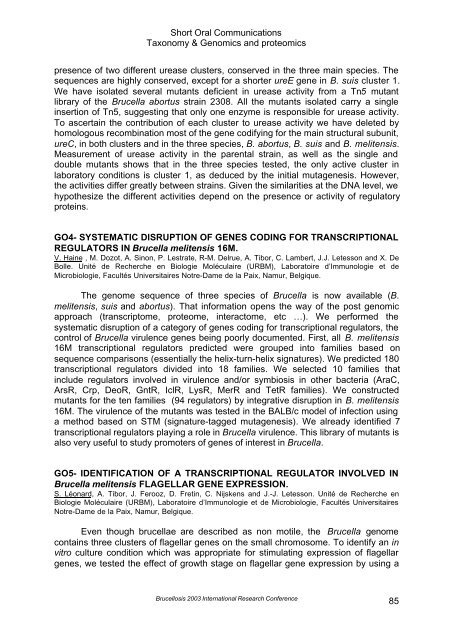Brucellosis 2003 proceedings - PHIDIAS
Brucellosis 2003 proceedings - PHIDIAS
Brucellosis 2003 proceedings - PHIDIAS
Create successful ePaper yourself
Turn your PDF publications into a flip-book with our unique Google optimized e-Paper software.
Short Oral Communications<br />
Taxonomy & Genomics and proteomics<br />
presence of two different urease clusters, conserved in the three main species. The<br />
sequences are highly conserved, except for a shorter ureE gene in B. suis cluster 1.<br />
We have isolated several mutants deficient in urease activity from a Tn5 mutant<br />
library of the Brucella abortus strain 2308. All the mutants isolated carry a single<br />
insertion of Tn5, suggesting that only one enzyme is responsible for urease activity.<br />
To ascertain the contribution of each cluster to urease activity we have deleted by<br />
homologous recombination most of the gene codifying for the main structural subunit,<br />
ureC, in both clusters and in the three species, B. abortus, B. suis and B. melitensis.<br />
Measurement of urease activity in the parental strain, as well as the single and<br />
double mutants shows that in the three species tested, the only active cluster in<br />
laboratory conditions is cluster 1, as deduced by the initial mutagenesis. However,<br />
the activities differ greatly between strains. Given the similarities at the DNA level, we<br />
hypothesize the different activities depend on the presence or activity of regulatory<br />
proteins.<br />
GO4- SYSTEMATIC DISRUPTION OF GENES CODING FOR TRANSCRIPTIONAL<br />
REGULATORS IN Brucella melitensis 16M.<br />
V. Haine , M. Dozot, A. Sinon, P. Lestrate, R-M. Delrue, A. Tibor, C. Lambert, J.J. Letesson and X. De<br />
Bolle. Unité de Recherche en Biologie Moléculaire (URBM), Laboratoire d’Immunologie et de<br />
Microbiologie, Facultés Universitaires Notre-Dame de la Paix, Namur, Belgique.<br />
The genome sequence of three species of Brucella is now available (B.<br />
melitensis, suis and abortus). That information opens the way of the post genomic<br />
approach (transcriptome, proteome, interactome, etc …). We performed the<br />
systematic disruption of a category of genes coding for transcriptional regulators, the<br />
control of Brucella virulence genes being poorly documented. First, all B. melitensis<br />
16M transcriptional regulators predicted were grouped into families based on<br />
sequence comparisons (essentially the helix-turn-helix signatures). We predicted 180<br />
transcriptional regulators divided into 18 families. We selected 10 families that<br />
include regulators involved in virulence and/or symbiosis in other bacteria (AraC,<br />
ArsR, Crp, DeoR, GntR, IclR, LysR, MerR and TetR families). We constructed<br />
mutants for the ten families (94 regulators) by integrative disruption in B. melitensis<br />
16M. The virulence of the mutants was tested in the BALB/c model of infection using<br />
a method based on STM (signature-tagged mutagenesis). We already identified 7<br />
transcriptional regulators playing a role in Brucella virulence. This library of mutants is<br />
also very useful to study promoters of genes of interest in Brucella.<br />
GO5- IDENTIFICATION OF A TRANSCRIPTIONAL REGULATOR INVOLVED IN<br />
Brucella melitensis FLAGELLAR GENE EXPRESSION.<br />
S. Léonard, A. Tibor, J. Ferooz, D. Fretin, C. Nijskens and J.-J. Letesson. Unité de Recherche en<br />
Biologie Moléculaire (URBM), Laboratoire d’Immunologie et de Microbiologie, Facultés Universitaires<br />
Notre-Dame de la Paix, Namur, Belgique.<br />
Even though brucellae are described as non motile, the Brucella genome<br />
contains three clusters of flagellar genes on the small chromosome. To identify an in<br />
vitro culture condition which was appropriate for stimulating expression of flagellar<br />
genes, we tested the effect of growth stage on flagellar gene expression by using a<br />
<strong>Brucellosis</strong> <strong>2003</strong> International Research Conference<br />
85
















